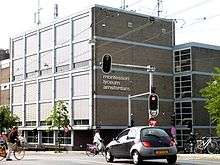Montessori Lyceum Amsterdam
Content in this edit is translated from the existing Dutch Wikipedia article at nl:Montessori Lyceum Amsterdam; see its history for attribution.
| Montessori Lyceum Amsterdam | |
|---|---|
 | |
| Address | |
Pieter de Hoochstraat 59 1071 ED Amsterdam Netherlands | |
| Coordinates | 52.355055°N 4.885515°E |
| Information | |
| Founded | 1930 |
| Head of school | Wrister Grommers |
| Slogan | "More than education alone" |
| Song | The Little Pioneer |
| Affiliation | Montessori Comprehensive School Amsterdam Foundation |
| Website | Montessori Lyceum Amsterdam |
The Montessori Lyceum Amsterdam, shortly MLA, is a school in Amsterdam Zuid. It was the first Montessori secondary school in the world.[1]
The school is a lyceum with the directions vwo (atheneum and gymnasium), havo and vmbo-t.[2]
The school is part of the Montessori Scholengemeenschap Amsterdam, or MSA, which encompasses five schools: Montessori Lyceum Amsterdam, Montessori College Oost, IVKO School, the Cosmicus Montessori Lyceum and Amstellyceum.[3]
The schools main entrance is located on Pieter de Hoochstraat.[4] The school comprises four main buildings and one building across the road. The school is the largest of the "MSA" schools, it has 1526 students and 137 teachers.[5]
Students at the Montessori Lyceum Amsterdam work with a special system for doing their school work. There are periods of nine weeks called a "blok". In this period, pupils need to complete a set amount of homework. Each year has four "blokken".[6]
History
In 1928, some parents set up the 'Foundation for Senior and Preparatory High Montessori education '. On 11 September 1930 the school started its first day.[7] On the second floor of a house at De Lairessestraat 157 fifteen students, two executives and eight teachers started the lessons.[8] This was unique because Maria Montessori (who first came to the school in 1932 to see how the school functioned) only focused on primary schools.[9]
The second year the number of students doubled, therefore the building across the street (De Lairessestraat 156) also had to be rented.[10]
Because the teaching method at the Montessori Lyceum was different from regular schools, it took quite some time before the school was officially recognized (and more important subsidized).[9] The school was also not allowed to take the final exam. In 1940 there was a small change, a part of the school (the girls' school, which in the years became more and more self-contained) was considered for subsidy by the government, which was already fled to England because of the war.
During World War II
The Lyceum started the war years from an economically unstable position. The chairman of the board was Hilda Gerarda de Booy-Boissevain (1877–1975)[10] and secretary was Adelheid Debora Cnoop Koopmans-van Tienhoven (1893–1988), she was called Daisy.
Trying to subordinate the suppression of the occupier, they made a list in August 1941 (five months after the February strike) with the names of all the Jewish students and teachers. The list was given to the occupier around 11 September.[11]
- Jewish Students
Around 1940 the school established the Jewish Montessori Lyceum,[11] where Jewish students and teachers (accounting for 1/3 of the school population) were placed. The school was recognized by Prof. Dr. Jan van Dam.[12] The aim was to have this school run as parallel as possible to the Montessorilyceum. The Jewish Montessori Lyceum closed in 1942 because there were no more students and teachers left.[11]
In 2005 a plaque was unveiled in memory of the students and teachers of the Montessori Lyceum who died during the Second World War:[13]
|
|
It was striking that the school seemed to be more concerned to the occupier about the financial consequences of the removal of Jewish students than the measure itself. Presumably this is because there was hope for subsidy and this seemed to be the best option. In 1941 the Ministry of Education announced that the Montessori Lyceum would be put on the list to be fully subsidized and on 9 October of that same year it was decided that the Montessori Lyceum was fully recognized.[14]
After World War II
After the war the school started a period of growth. In 1957 it was time for a move again, this time to the Anthonie van Dijckstraat. In the 1950s there was a lot of experimenting with new pedagogical ideas.[15] Remains of this are the work weeks and the part-schools. At the end of the 60s it almost went wrong. The country became more democratic and people wanted to have more information and participation. Between September 1968 and January 1970, the conflicts played up in full force.[16] It even came so far that a broad-based plan arose to allow external advisers to look at the problem. Ironically, the sudden death of the rector caused that the school fell into a completely embittered state and all the problems seemed to be gone.[9]
In the ten years that followed, the number of students raised to more than a thousand. During this time some schools merged into the Montessori Scholengemeenschap Amsterdam. In 1977, the school exchanged buildings with the Ignatius College and ended up on the Pieter de Hoochstraat.[17][18]
Notable (old-)students
- Theo van Gogh (he died as a member of the resistance in the World War II and he was the uncle of the murdered movie director Theo van Gogh)
- Marius Gottlieb (actor, known from the youth series SpangaS)
- Jasper Gottlieb (actor, known from the youth series SpangaS)
- Sallie Harmsen (actress)
- Willem Voogd (actor)
- Manuel Broekman (actor)
- Judith Herzberg (writer)
- Felix Rottenberg (old-chairman from the PvdA)
- Mance Post (illustrator)
- Trijntje Oosterhuis (singer)
- Tjeerd Oosterhuis (producer)
- Hadassah de Boer (presenter)
- Tatum Dagelet (presenter)
- Candy Dulfer (saxophonist)
- Johan van der Keuken (moviemaker and photographer)
- Herman Koch (writer)
- Klaas van der Eerden (comedian)
- Caro Lenssen (actress)
- Cyrus Frisch (director)
- Mark Rietman (actor)
- Joram Lürsen (movie director)
- Paul Cohen (documentary producer)
- Willem Asman (writer)
- Aukelien Weverling (writer)
- Adriaan Rees (artist)
- Nada van Nie (presenter, actress and singer)
- Clovis Cnoop Koopmans (children judge, vice president of the Amsterdam Court, First Chamber member for the PvdA, PvdA city councilor Amsterdam and nature conservationist)
- Gabi van Driem (lawyer, feminist, writer, founder of the Rechtswinkel Amsterdam)
- Kietje Sewrattan (actress)
- Eric Vaarzon Morel (flamenco guitarist)
- Herman Hertzberger (architect)
- Mirjam Rotenstreich (writer)
List of Presidents of the Student Council
| Council | Name | Picture | Term of Service |
|---|---|---|---|
| 1st
2nd |
S.Z. ter Hart |  |
1 Jan 2017 -
5 Jul 2019 |
| 2nd | Yasmina Derraze | 5 Jul 2019 - |
External links
- Montessori Lyceum Amsterdam (in Dutch)
- Website of the MLA
- Schoolwijzer van de Gemeente Amsterdam about the MLA
References
- "Secondary Montessori Education in the Netherlands the Montessori Lyceum Amsterdam 1930... | Montessori Australia Foundation".
- http://www.montessorilyceumamsterdam.nl/ontdek-het-mla/over-de-school/onderwijsniveaus
- "Montessori Scholengemeenschap Amsterdam".
- "Montessori Lyceum Amsterdam".
- "Montessori Lyceum Amsterdam | Aantal leerlingen".
- http://www.montessorilyceumamsterdam.nl/ontdek-het-mla/ons-onderwijs/in-de-praktijk
- https://www.msa.nl/OverMSA/OntstaanMSA/tabid/938/Default.aspx
- http://www.kelpin.nl/fred/download/montessori/algemeen/prentenboek.pdf
- Montessori magazine (PDF) https://www.montessori.nl/files/media/mm/37-4_Montessori_Magazine.pdf. Missing or empty
|title=(help) - "History of the Amsterdam's Montessori Lyceum" (PDF).
- "Jewish Montessori Lyceum".
- http://www.eenkleineheldendaad.nl/categorie/index.php?cat=ontjoodsing
- https://www.online-begraafplaatsen.nl/zerken.asp?command=showzerken&bgp=2343&page=5
- https://www.ru.nl/publish/pages/.../0025_-_architect_van_onderwijsvernieuwing.pdf
- https://didactiefonline.nl/blog/blonz/existentialisme-en-onderwijs-na-wo2
- http://www.dbnl.org/tekst/boek009gesc01_01/boek009gesc01_01.pdf
- http://www.ig.nl/Website2011/Overdeschool/Geschiedenis/tabid/1035/Default.aspx
- http://www.montessorilyceumamsterdam.nl/ontdek-het-mla/over-de-school/geschiedenis